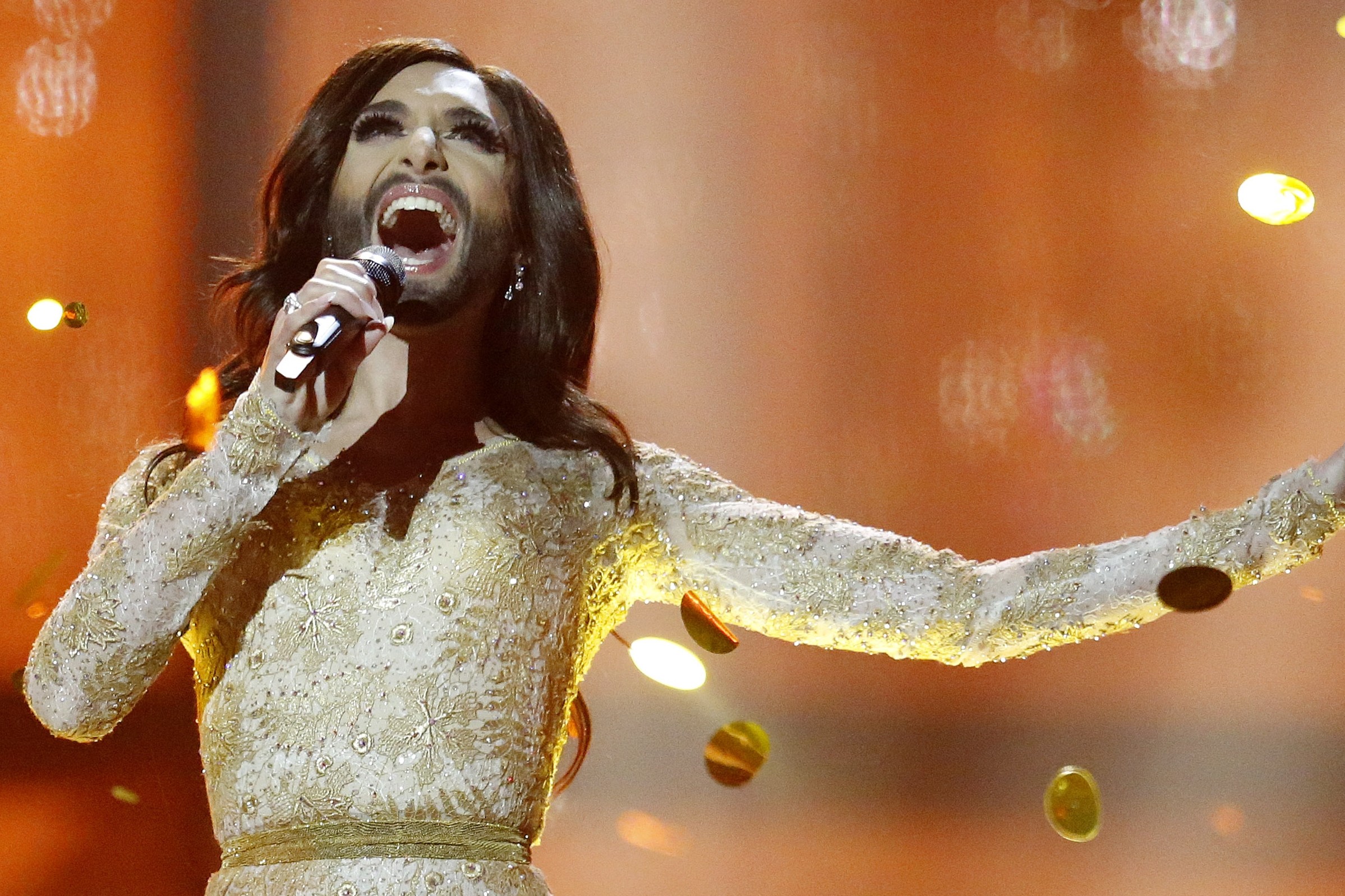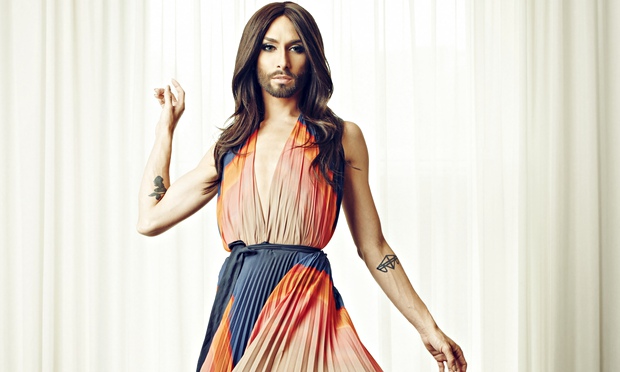One of the topics that has interested me the most throughout my academic life is that of gender, as well as the performative nature of femininity. When I started the MA in Fashion Studies, one of the first classes I chose to take was “Fashion and the Body.” This short essay was part of my coursework for the class.

On 11 May 2014, Conchita Wurst rose like a Phoenix to win the Eurovision Song Contest, one of the most important TV shows in Europe, and the biggest singing competition in the world (“The Story”). When seeing Conchita Wurst’s performance at the second semi-final of the Eurovision Song Contest, it takes one full minute before the video shows a close-up of her face, revealing she is not the typical female pop star, since one of the most noticeable aspects of her face is the presence of a manly beard (Conchita Wurst). But other than the beard, she portrays all the common characteristics of female pop stars; she wears a beige “mermaid” dress with golden embroideries, has a slim body with subtle curves that lies within the Western ideal of female beauty, her hair is long and wavy, and she wears astonishing jewelry and makeup. Once the details of her face are revealed, her beard stands out as the most important characteristic of Conchita Wurst’s appearance, making her gender almost impossible to define, and marking her difference from the crowd.
When talking about the construction of gender norms, Judith Butler explains the importance of repetition as the key element to achieve the longevity of such norms. To her, it is the “domestication” of repetitions what leads to the construction of gender in a cultural hegemony (Judith Butler, 2006, 139). From this domestication, results one of the most important binary forms of categorization that exist in the West, namely, the differentiation between men and women. This gender differentiation, Butler explains, “is an identity tenuously constituted in time, in an exterior space through a stylized repetition of acts … a constituted social temporality” (Judith Butler, 2006, 140). It can be seen, therefore, that it was through the repetition of the most powerful of men having beards—kings, knights and warriors, for example—that it became such an important element in the representation of masculinity in Western society. Conversely, the constant repetition of women wearing dresses and being delicate beings was what built the still existing feminine identity in the West.

The construction of gender binary oppositions based on difference reveals the power relations present in society, as difference is used in order to give meaning to “other cultures” by the use of discourses and practices in the West (Stuart Hall, 1997, 225). This categorization of individuals, grounded on binary oppositions, allows us to construct the “Other,” based on a “them rather than us” system of differentiation (Stuart Hall, 1997, 229). Thus, the apparent difference between men and women is a social construct that results from the relationships between individuals in society, where women tend to be in a lower level of the power hierarchy than men (Pierre Bourdieu, 1987). In this system, the dominant culture is that of the white male and women become the Other—in a dual opposition between “us” men and “them” women.
However, because it is a social construct, gender is open to “resignification and recontextualization; parodic proliferation deprives hegemonic culture and its critics of the claim to naturalized or essentialist gender identities” (Judith Butler, 2006, 138). It is here where Conchita Wurst enters the game. In her being a “long-haired full-bearded lady” (“About Conchita Wurst”), the chance of gender transformation exists, since these opportunities “are to be found precisely… in the possibility of a failure to repeat, a de-formity, or a parodic repetition that exposes the phantasmatic effect of abiding identity as a politically tenuous construction”(Judith Butler, 2006, 141).
Through her representation, Conchita Wurst challenges the normative ideals of the West, thus leading to the reconsideration of masculinity and femininity. If we ignore her beard, she might be accused of using her performance as a way to maintain gender within the binary frame by choosing to look like a woman in the way in which she dresses, styles her hair, and uses makeup. However, because of the beard, she is challenging the binary opposition normally used to establish gender difference. She embodies both the ideal of femininity—in the way she dresses, talks and acts—and the ideal of masculinity—by having a perfectly groomed beard—at once.
.jpg)
Conchita Wurst and her beard, rather than becoming a weird, unrecognizable, and unclassifiable “Other,” have become widely appreciated in the Western hemisphere, which can be acknowledged from the fact that it was the audience what gave her the winning trophy of the European Song Contest. Her beard has become not only a mark of her uniqueness as a “female” pop singer, but also of her importance as the “symbol for tolerance and artistic freedom in Austria and beyond” (“About Conchita Wurst”). In a recent interview, Conchita Wurst declares:
You know, I’m a member of the gay community… and being a teenager in this small village wasn’t the funniest thing on Earth, so over the years I tried to fit in and I changed myself in every, every way you can imagine, I just wanted to be part of the game. And then I realized, well, I create the game (“About Conchita Wurst”).
By creating her own game she has become a key element in the reconstruction of masculine and feminine ideals. Her beard is the materialization of a subversive strategy that interrupts and breaks into the stability of binary oppositions that differentiate men from women in Western culture. She is breaking the appearance of difference, thus is shifting the ideals of both masculinity and femininity.
—
Bibliography
“About Conchita Wurst,” Eurovision Song Contest, accessed 26 September 2014, http://www.eurovision.tv/page/history/year/participant-profile/?song=31403.
Bourdieu, Pierre. “What Makes a Social Class? On the Theoretical and Practical Existence of Groups,” Berkeley Journal of Sociology 32 (1987): 1-17.
Butler, Judith. “Bodily Inscriptions, Performative Subversions.” In Gender Trouble: Feminism and the Subversion of Identity. 10th Anniversary Edition, 175-193. London; New York: Routledge, 2006.
Hall, Stuart. “The Spectacle of the “Other.”” In Representation: Cultural Representations and Signifying Practices, edited by Stuart Hall, 223-290. London: Thousand Oaks, CA; New Dehli: Sage, 1997.
“The Story,” Eurovision Song Contest, accessed 26 September 2014, http://www.eurovision.tv/page/history/the-story.
Wurst, Conchita. “Conchita Wurst – Rise like a Phoenix (Austria) 2014 LIVE Eurovision Second Semi-Final.” YouTube video, 3:22. Posted by “Eurovision Song Contest,” 8 May 2014. https://www.youtube.com/watch?v=SaolVEJEjV4.
Pingback:On Graduating From Parsons MA in Fashion Studies – Atelier de Marques